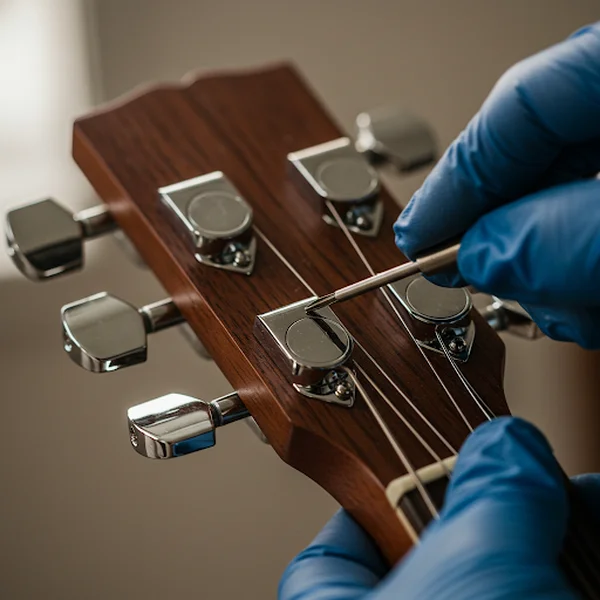Guitar Out of Tune? Top Causes & Easy Fixes
Is your guitar constantly guitar out of tune, making practice sessions and performances a frustrating experience? Why does my guitar go out of tune so often? This is a common lament among guitarists of all levels. The good news is that in many cases, the reasons your instrument won't stay in tune are identifiable and often easily remedied. Before you spend money on a professional setup, let's explore the top culprits and the simple fixes you can apply to keep your guitar in tune and sounding its best. For accurate initial tuning, you can always try our free tuner.
Common Culprits: Why Your Guitar Goes Out of Tune
Understanding the root guitar tuning problems is the first step. Several factors can contribute to your guitar's inability to hold its pitch.
New Guitar Strings: The Stretching-In Period
Why do new strings go out of tune so quickly? Freshly installed new guitar strings need time to stretch and settle. As you play, the strings will gradually elongate until they reach a stable length. During this initial period, frequent re-tuning is normal. Patience and proper stretching techniques are key.

Old or Worn-Out Strings: Losing Their Tuning Stability
Conversely, old guitar strings can also cause guitar tuning stability issues. Over time, strings accumulate dirt and grime, corrode, and lose their elasticity and ability to vibrate consistently. They may develop flat spots from fret wear, all of which makes it difficult for them to hold a tune accurately.
Tuning Pegs and Hardware Issues
Sloppy or tuning pegs slipping are a frequent source of tuning woes. If your tuning machines are loose, worn, or of low quality, they may not be able to hold the string tension effectively, causing the pitch to drop. Other hardware like loose screws on the bridge or tailpiece can also contribute.
Nut and Bridge Problems: Friction and Binding
The nut and bridge saddles are critical points where strings make contact. If the slots in the nut are too tight, not smooth, or improperly cut for your string gauge, strings can bind. This guitar nut friction prevents the string from moving freely, leading to tuning inaccuracies, especially after string bends or using a tremolo. The same applies to worn or poorly shaped bridge saddles.

Environmental Factors: Humidity and Temperature Swings
Does humidity affect guitar tuning? Absolutely. Guitars are primarily made of wood, which is hygroscopic – meaning it absorbs and releases moisture based on the surrounding environment. Sudden changes in humidity affects guitar significantly, causing the wood to expand or contract. This movement can alter string tension and throw your guitar out of tune. Similarly, drastic temperature affects guitar tuning.
Playing Style and Technique
Your playing style can also impact tuning. An aggressive playing style with heavy strumming, frequent string bends, or whammy bar abuse will naturally put more stress on the strings and tuning system, potentially causing them to go out of tune faster than a more delicate approach.
Structural Issues: Neck Relief and Intonation
More serious guitar intonation problems or incorrect neck relief (the slight curve of the neck) can lead to persistent tuning issues across the fretboard. While these might require more advanced adjustments, understanding them is part of comprehensive guitar tuning troubleshooting.
Simple Fixes and How to Keep Your Guitar in Tune
Now that we've identified some common causes, let's look at how you can fix tuning problems and implement strategies to keep your guitar in tune.
Properly Stretching New Strings
When you install new guitar strings, take the time for stretching guitar strings correctly. Tune each string to pitch, then gently pull it upwards away from the fretboard a few times along its length. You'll likely hear the pitch drop. Retune and repeat until the string holds its pitch after stretching. This significantly reduces the break-in period.
Regular String Changes and Cleaning
When to change guitar strings depends on how much you play, but a good rule of thumb is every 1-3 months for regular players. Clean strings also sound better and last longer. Wipe them down after each playing session to remove oils and sweat.
Checking and Tightening Tuning Hardware
Periodically check your tuning pegs. If any are loose, you might be able to tighten loose tuning pegs with a small screwdriver or wrench (depending on the type). Be careful not to overtighten. Ensure all screws on the bridge and other hardware are snug.

Lubricating the Nut and Bridge
To combat string binding, lubricate guitar nut for tuning and bridge saddles. A small amount of graphite (from a pencil tip) or a specialized string lubricant applied to the slots can make a big difference in guitar tuning stability.
Maintaining a Stable Environment for Your Guitar
Try to maintain consistent guitar storage humidity levels, ideally between 45-55%. Use a humidifier or dehumidifier in your guitar's case or room if necessary. Avoid exposing your guitar to rapid temperature changes, like leaving it in a hot car or near a cold window.
Proper Tuning Technique with Our Online Tool
Always tune up to the correct pitch. If you go sharp, tune down below the note and then back up. This helps seat the string properly in the nut and on the tuning peg. For reliable and precise tuning, using online tuner correctly is essential. An accurate online instrument tuner can be your best friend here.

When to Seek Professional Help
While many guitar tuning problems can be resolved with these simple fixes, sometimes the issue is more complex. If you've tried these steps and your guitar won't stay in tune, or if you suspect structural issues like severe neck warp or incorrect intonation that you're not comfortable adjusting, it's time to consult a qualified guitar technician for guitar repair.
Enjoy a Consistently Tuned Guitar
Achieving consistent guitar tuning stability is often a matter of understanding the common culprits and applying some basic maintenance. By addressing issues with strings, hardware, environment, and technique, you can significantly reduce the frustration of a guitar out of tune. Remember that a well-maintained guitar is a joy to play.
Your Guitar Tuning Problem Questions Answered
Here are answers to some common questions about guitar tuning troubleshooting:
Why does my cheap guitar go out of tune so easily?
Cheap guitar tuning issues often stem from lower-quality hardware (tuning pegs, nut, bridge) and sometimes less stable wood or construction. While you can improve things with better strings and proper setup, inherent limitations might exist. However, ensuring it's tuned accurately with a tool like an easy-to-use online tuner is always the first step.
How often should I tune my guitar?
Ideally, you should check your tuning every time you pick up your guitar to play. Strings can be affected by even minor changes in temperature or humidity, or simply by being played. How often to tune guitar also depends on the instrument's stability.
Can using an online tuner help improve tuning stability?
While an online tuner itself doesn't directly improve the physical stability of your guitar, using online tuner correctly ensures you are starting from an accurately tuned point. This helps you identify if the problem lies with the guitar itself or your tuning method. An accurate online tuner provides a reliable reference, making it easier to diagnose why your guitar might be losing its tune.